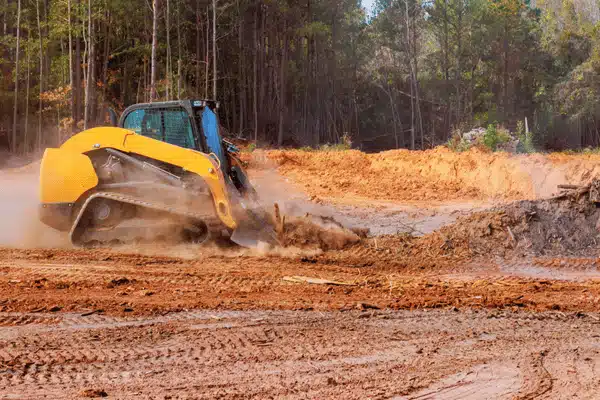
Grading and leveling are two essential land preparation processes that homeowners and builders often confuse. While these terms sound similar, they serve different purposes in construction projects and landscaping tasks. Land grading creates controlled slopes to direct water flow and prevent pooling, while land leveling produces a uniform surface for specific uses like lawns or building pads.
Understanding these key differences helps you choose the right approach for your property needs. Whether you're dealing with drainage issues, preparing for construction projects, or improving your outdoor spaces, knowing when to use each process saves time and money while protecting your investment.
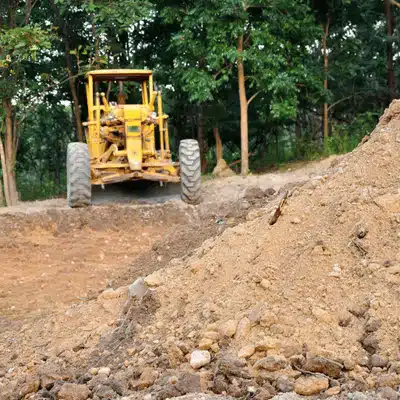
Land grading reshapes your property's surface to create specific slopes that control water movement and prepare sites for construction. By following natural contours or cutting and filling uneven ground, crews achieve the desired slope essential for efficient drainage and successful land development. Costs often break down by square foot, so knowing the elevation change per square foot helps estimate material shifts and equipment time accurately.
Grading shapes your land to establish a gentle slope that moves water away from structures and toward appropriate drainage areas. Around homes, experts recommend a desired slope of about 5% - dropping six inches over the first ten feet from your foundation. This controlled grading prevents water from pooling against your house, which could cause serious foundation damage.
Landscape grading involves cutting high areas and filling low spots to create smooth transitions across your property. Professional contractors use surveying tools to ensure slopes meet engineering specifications while maintaining attractive contours that blend naturally with surrounding terrain.
Proper grading forms the backbone of effective drainage systems. By shaping your land's surface, grading channels rainwater along predetermined paths instead of letting it collect in problematic areas. This controlled water flow prevents soil erosion and protects both your landscaping and structural elements.
Erosion control works hand-in-hand with grading projects. After reshaping terrain, contractors often install erosion control measures like silt fences, seed disturbed areas, and create swales that naturally manage stormwater. These techniques prevent soil runoff while maintaining the intended grade.
Construction projects require proper land leveling and grading to create stable building platforms. Preparation involves rough grading to establish general elevations, followed by fine grading to achieve exact specifications. This process ensures structures rest on solid, properly drained ground.
Commercial construction and residential projects both depend on skilled grading to meet building codes. Local regulations typically require specific drainage patterns around structures, making professional grading essential for permit approval and long-term performance.
Grading services use heavy machinery like bulldozers, excavators, and motor graders to move earth efficiently. Skid steer loaders handle smaller areas or tight spaces where larger equipment cannot operate effectively. Modern specialized equipment includes laser leveling systems that provide precise grade control.
The grading process typically starts with rough grading using powerful dozers to establish basic contours. Fine grading follows, using more precise tools to achieve exact slopes and smooth surfaces. Careful planning ensures each phase builds toward the final grade specifications.
Land leveling creates flat surfaces by eliminating elevation variations across specific areas. Crews grade inch by inch, calculating costs per square foot to achieve the desired uniform height over every square foot of soil. While the goal is flatness, precisely leveled ground can still improve drainage in garden beds, patios, and sports fields by preventing low spots that collect water.
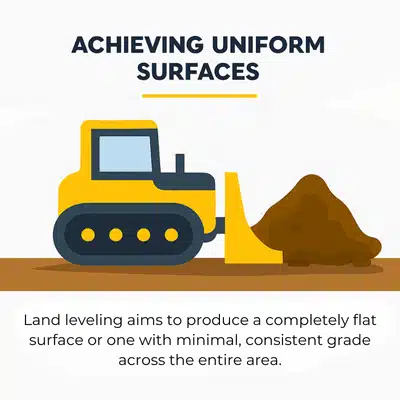
Land leveling aims to produce a completely flat surface or one with minimal, consistent grade across the entire area. This uniformity ensures efficient water distribution for irrigation systems and creates stable platforms for various uses. Land leveling eliminates bumps, depressions, and other irregularities that could interfere with intended functions.
Agricultural applications benefit greatly from precision leveling. Laser leveling systems guide equipment to achieve millimeter-accurate flatness, ensuring efficient irrigation and maximizing crop growth potential. This technology has revolutionized farming by reducing water waste and improving yields.
Yard leveling transforms bumpy lawns into smooth, attractive surfaces that are easier to maintain and safer to use. Lawn leveling eliminates water pooling areas where mosquitoes breed and creates consistent growing conditions for grass. A level surface also provides better foundations for patios, sheds, and play equipment.
Landscaping companies often combine leveling with other services to create comprehensive outdoor improvements. After achieving a proper surface, they may install irrigation systems, plant new lawns, or prepare areas for hardscaping features.
Both land leveling and grading play crucial roles in construction projects. While grading establishes overall drainage patterns, leveling creates precise platforms for structures. Building pads must be level to ensure proper foundation performance and prevent structural issues.
Construction site preparation frequently requires both processes in sequence. Contractors first grade the property to establish drainage, then level specific areas where structures will be built. This combination approach ensures both proper drainage and stable foundations.
Modern land leveling employs advanced technology for exceptional accuracy. Laser leveling systems use rotating lasers to maintain consistent reference heights, while GPS-guided equipment follows digital terrain models. These innovations ensure precise results while reducing labor costs and project timelines.
Heavy equipment used for leveling includes specialized scrapers, land planes, and grading attachments. The choice depends on project size and precision requirements. Small residential projects might use compact equipment, while large agricultural fields require powerful tractors with laser-guided implements.
Understanding the differences between land grading and land leveling helps you choose the appropriate service for your specific needs. These two processes serve distinct purposes and produce different results.

Land grading aims to create controlled slopes that direct water flow and prevent drainage problems. The primary objective is shaping terrain to achieve specific grades and contours. Land leveling focuses on creating flat surfaces that eliminate elevation variations within defined areas.
These different goals require different approaches and equipment. Grading projects consider existing topography and water drainage patterns, while leveling prioritizes achieving consistent elevation across the work area.
Grading and leveling handle water differently. Grading controls water flow by creating slopes that channel runoff away from structures and toward appropriate outlets. This approach prevents and reduces erosion risks.
Leveling ensures efficient water distribution by eliminating high and low spots that could cause uneven irrigation coverage. While leveled areas still need slight grades for drainage, the focus is on uniformity rather than directing flow.
Land grading is essential for construction projects, land development, and drainage planning. It addresses grave slopes, creates buildable sites, and solves drainage issues. Landscape grading also enhances property aesthetics by creating attractive contours.
Land leveling serves agricultural needs, landscaping projects, and specific construction requirements. It prepares fields for irrigation, creates smooth lawns, and provides level building pads. Cubic yard calculations help contractors determine material needs for each application.
After grading, your property will have intentional slopes, berms, and drainage features designed to manage water effectively. The land topography reflects planned contours that serve specific functions while maintaining attractive appearances.
Leveling produces level surfaces with minimal elevation variation. While not perfectly flat (slight drainage slopes remain necessary), leveled areas provide consistent platforms for their intended uses.
Both land leveling and grading use similar heavy equipment, but precision requirements differ. Grading tolerances typically allow for slight variations as long as overall slopes meet specifications. Leveling demands greater accuracy, especially for applications like sports fields or precision agriculture.
Specialized equipment for leveling includes laser-guided scrapers and GPS-controlled blades. These tools achieve the uniformity required for optimal performance in their intended applications.
Determining whether you need grading services, leveling, or both depends on your specific property conditions and project goals. Common scenarios help illustrate when each process is most appropriate.
Drainage problems around structures typically require grading land to create proper slopes. If water pools against your home's foundation or flows toward buildings, regrading establishes slopes that direct water flow away from problem areas.
Water pooling in yard areas might need leveling to eliminate low spots, combined with slight grading to ensure runoff reaches appropriate outlets. Professional assessment helps determine which approach best solves your specific drainage challenges.
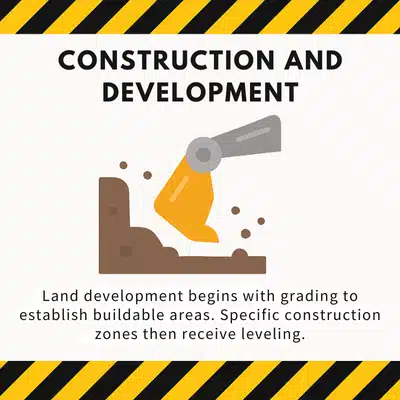
Construction projects almost always require both processes. Land development begins with grading to establish overall site drainage and buildable areas. Specific construction zones then receive leveling to create precise platforms for foundations and structures.
Preparation for homes, driveways, and other improvements follows this pattern. Contractors grade the property to manage water, then level areas where structures will be built. This combination ensures both proper drainage and stable foundations.
Landscaping projects benefit from both processes depending on goals. Land leveling creates smooth lawns and eliminates trip hazards, while landscape grading establishes attractive contours and drainage patterns.
Outdoor spaces like patios and play areas typically need level foundations, while surrounding areas require grading to direct water away from these features. Landscaping businesses coordinate both processes to create comprehensive improvements.
Farming operations need better irrigation and water drainage, making land leveling essential for crop production. Level fields ensure uniform water distribution and prevent waste. Crop growth improves significantly when irrigation reaches all areas equally.
Land grading depends on field conditions and farming methods. Sloped fields might need terracing or contouring to prevent erosion, while level areas focus on achieving uniform elevation for optimal irrigation efficiency.
Severe slopes require land grading to create manageable grades and prevent soil erosion. Retaining walls often work with land grading to create level areas on sloped properties. This combination makes unusable steep terrain functional while controlling erosion.
Erosion control strategies integrate with land grading projects to stabilize newly shaped terrain. Careful planning ensures graded slopes remain stable and support vegetation establishment.
Professional land grading and land leveling projects follow systematic approaches that ensure quality results. Understanding this process helps you work effectively with contractors and achieve desired outcomes.
Land preparation begins with thorough site evaluation. Contractors assess existing topography, soil conditions, and drainage patterns to develop appropriate solutions. This assessment determines whether projects need land grading, land leveling, or both processes.
Sewage planning identifies where water should flow and establishes grade requirements. Professional surveyors often provide elevation data that guides equipment operators in achieving specified slopes and elevations.
Heavy machinery selection depends on project size and precision requirements. Large land grading projects use bulldozers and excavators, while precision leveling might require land leveling systems and GPS-guided equipment.
Skid steer loaders handle smaller areas or provide access where larger equipment cannot operate. Equipment choice affects both project cost and timeline, making proper selection important for efficiency.
The grading process typically involves multiple passes with different equipment. Rough grading establishes basic contours, while fine grading achieves exact specifications. Laser leveling systems provide continuous feedback to ensure accuracy.
Quality control measures verify that finished work meets specifications. Achieve the desired results through careful monitoring and adjustment during construction. Professional contractors guarantee their work meets agreed-upon standards.
Erosion control methods protect newly graded or leveled areas from weather damage. Seeding, mulching, and temporary barriers prevent soil runoff while vegetation establishes. These measures ensure long-term stability of shaped terrain.
Landscaping tasks like seeding and planting complete the process. Proper land leveling provides ideal conditions for establishing healthy lawns and landscaping features that enhance property value and function.
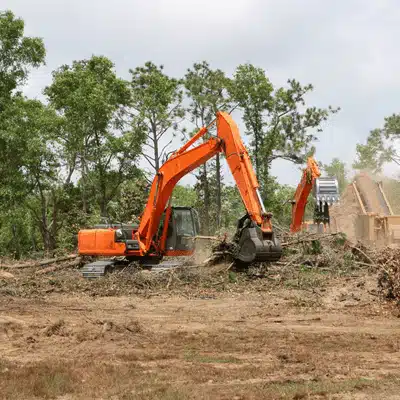
Current land grading procedures benefit from advanced technology that improves accuracy and efficiency. Leveling systems and GPS guidance have revolutionized earthmoving operations, delivering precision results while reducing costs.
Specialized equipment with automated controls achieves consistent results faster than traditional methods. These advances benefit property owners through improved quality and reduced project timelines.
Environmental considerations also influence modern practices. Erosion control protects water quality and comply with regulations. Sustainable approaches minimize environmental impact while achieving project goals.
Grading and leveling separate slope control from a flat surface. Land grading shapes specific slopes for water flow, prevent soil erosion, and fit drainage systems, while land leveling creates a flat surface for construction work, lawn leveling, and efficient irrigation. Land leveling always follows land grading to eliminate standing water.
Professional land grading contractors use precise leveling systems for shaping land projects. Land grading systems handle grading, drainage planning and retaining walls, ensuring drainage systems and a foundation. Regular land grading prevents pooling and runoff. Schedule land grading to support projects, improve land grading results, keep land grading maintenance aligned with regulations, and guarantee land grading.